Grafting Made Easy | Complete Tutorial of What It Is, How To, Tools You Need! (PHOTOS)
Grafting Made Easy!

Grafting really is quite easy, there's just a learning curve in the beginning. After reading this post, we hope you feel more confident and knowledgable trying a graft out yourself. In this post, we share the basics of grafting: tools you need, why to do it, what it entails, what can be grafting and then how to graft: different types and when to use them.
Earlier we shared a short video giving an overview of grafting and the importance it plays in fruit production. Here's the follow up where we'll dive into more detail about this ancient and marvelous technique for creating the fruit and nuts you want.
Getting the Genetics We Want

Ini feeling stoked in my sunnies with Plum and Persimmon Scions
Most of you probably know that if you plant a fruit seed you'll get fairly broad genetic diversity (although a few genus such as Amelanchier do come true to seed). Plant the seeds from the best tasting apple you've ever had and you may end up with a spitter (may be good cider apple though), but you won't know the fruit quality for years to come.
I read recently that less than 1 out of 10 000 apple seedlings will bear fruit that parallels its parent in quality.
The seedling route is great if you're looking for new varieties and are working on creating resilient and adaptable seedlings, certainly a worthwhile endeavor. Narrowing genetics can lead to disease and a reduction of vigor over time due to narrow genetic pool that is being propagated. BUT....
Focusing on selected varieties can increase quality and quantity of fruits.
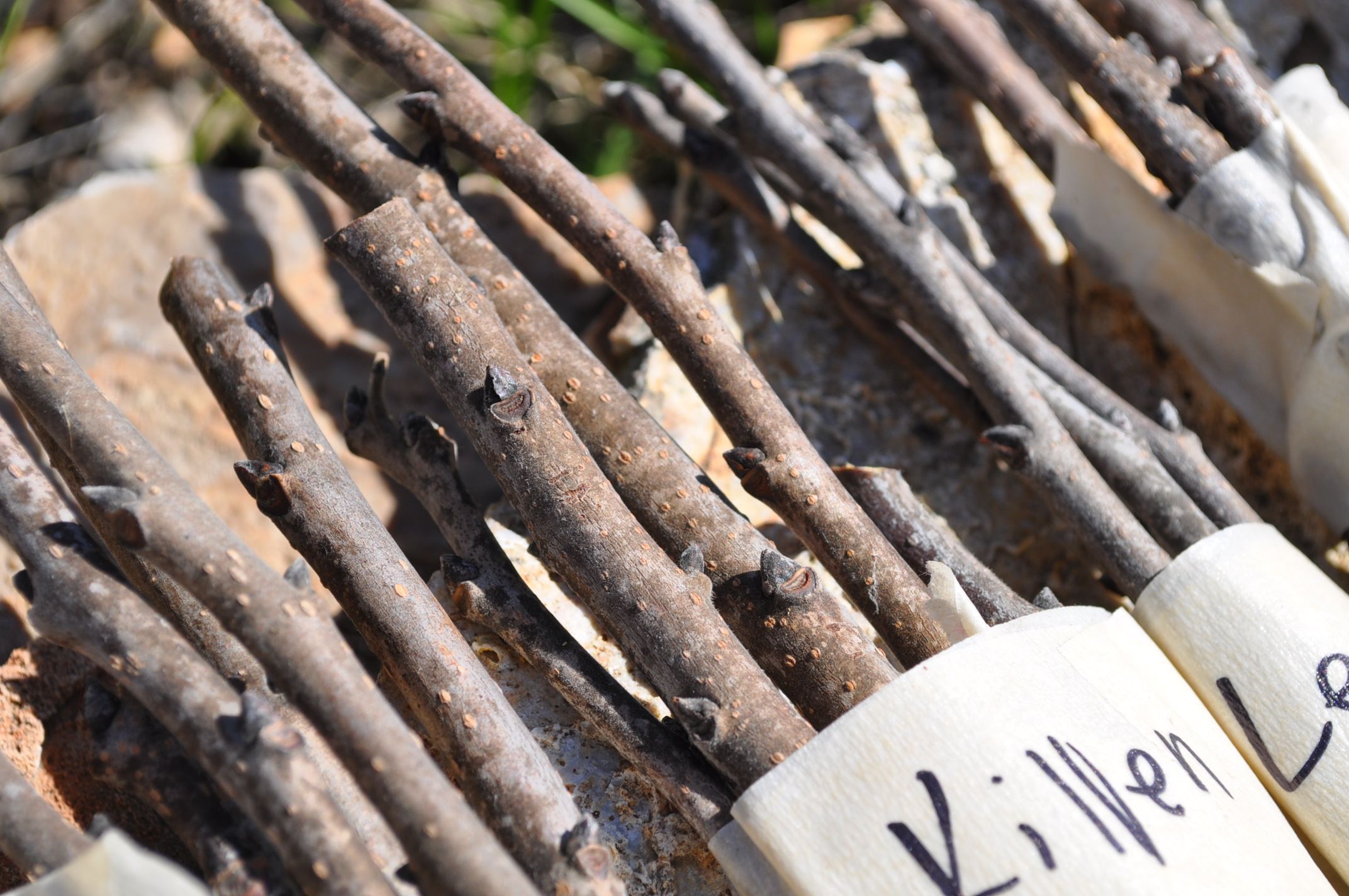
And it is delicious, nutritious and easy to consume fruit we're after. In our food forest, we have began the long journey to creating a complex and interconnected system of food production mimicking natural forest ecosystems. We are focusing on similar plants to those already growing here. We have abundant hickory, paw paws, persimmons, an unknown Eriacea species, a few mulberries and elderberries on our land.
This is where grafting really comes into play. By obtaining material from selected species, we can graft this onto our native trees. Also consider that not all fruit producing trees need to be grafted as there are many other ways to propagate such as layering, stooling, suckering, softwood and hardwood cuttings.

Working With Nature
Growing food can be a LOT of work, actually most of it is. But we can be intelligent and thoughtful in how we go about this yummy task. By choosing already existing trees to graft onto we are not transplanting, amending soil or even digging. With a meager investment, some simple tools and a little time we are working towards creating abundance for us and our community.
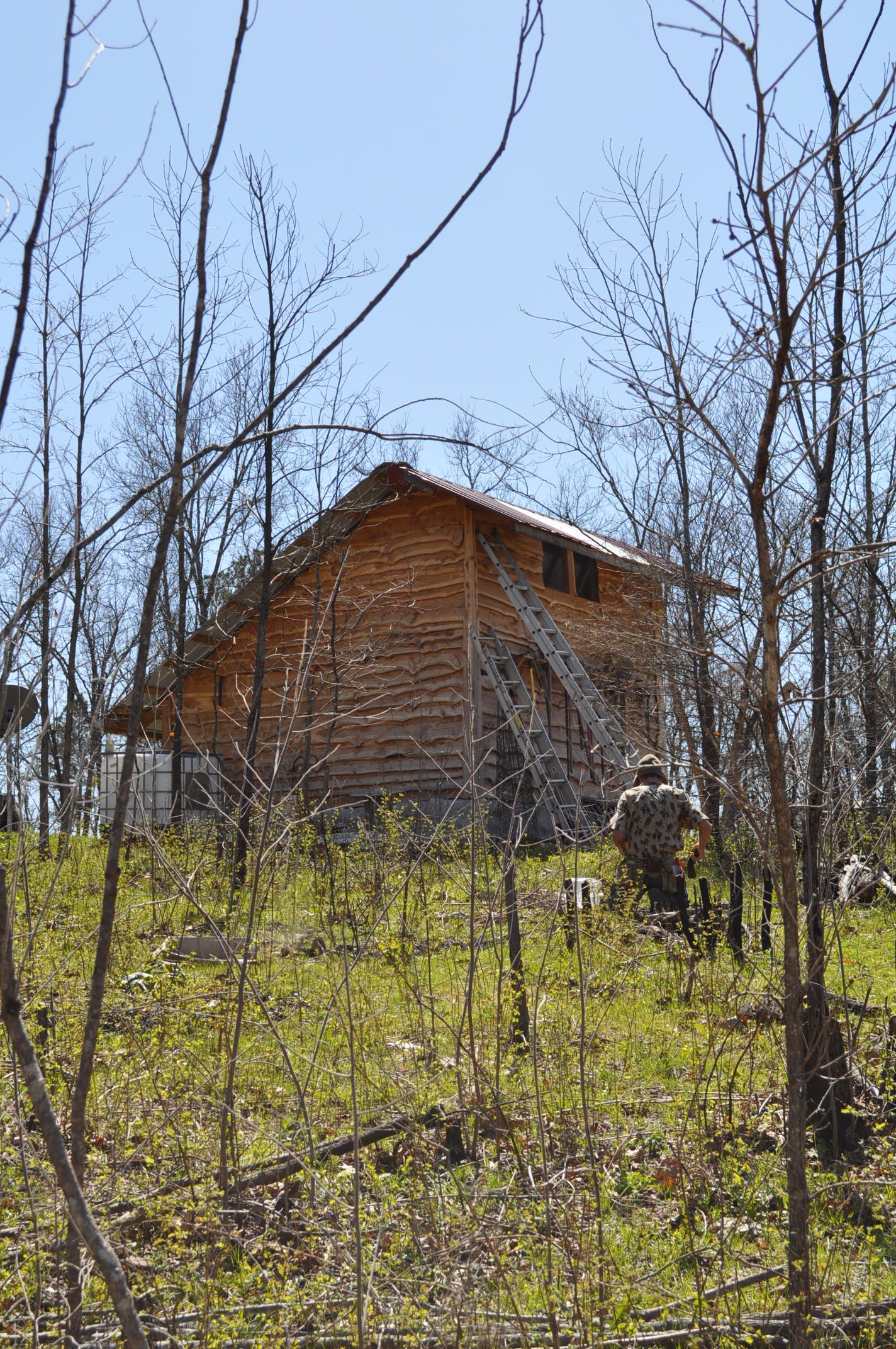
To graft, there are a few simple tidbits of plant biology that can be helpful to understand.
BASICS
- A successful graft or union is dependent on compatibility of scion (top) and rootstock (bottom). Two simple categories are STONES and STARS. Cut an apple or pear horizontally and you'll see a star, so they may be compatible (think of the Rosacea family). Stones includes fruits with pits like peaches, plum, nectarines etc (prunus genus)... Often species in the same genus will take such as pecan scion on hickory rootstock (Carya genus). Look up specifics as they are exceptions and anomalies.

As plants go into the colder months, they enter dormancy. It is important to cut scions during dormancy and keep them cool (a refrigerator works well) in order to have best results. Timing of grafting depends on species.
Just beneath the bark (sometimes called rind) is a layer known and the cambium which includes the zylem and phloem. These are where nutrients and fluids are transported throughout the plant. For a successful graft, the cambium of scion and rootstock must be be solidly connected.
Tools
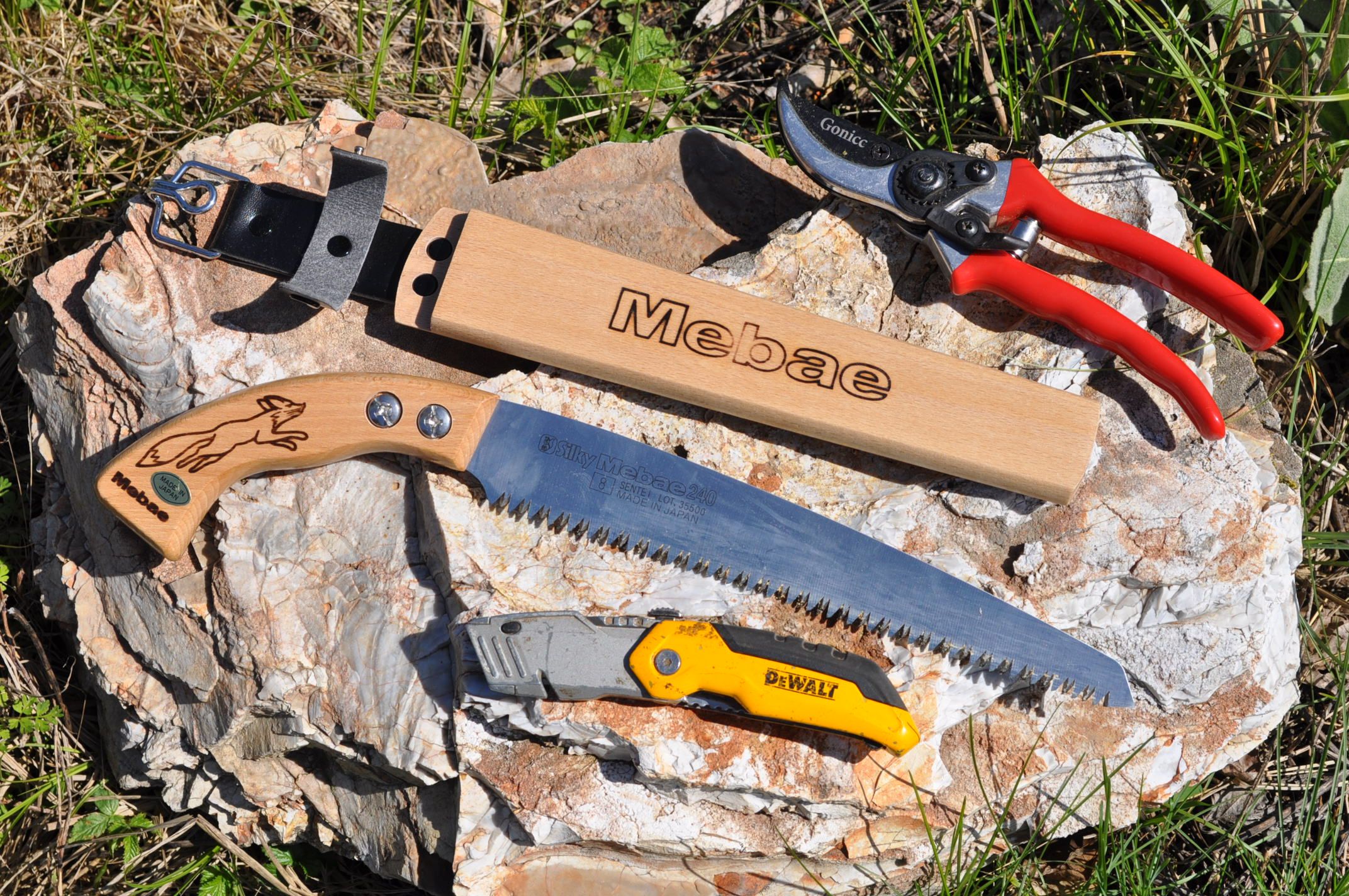
- The main tool needed to graft is a sharp knife. I use a utility blade, but I've heard old silver butter knives can be honed to a razor edge. Ideally the blade would be blunt not pointed.
- A sharp pruning saw is helpful for making swift and clean cuts of larger rootstock.
- Secateurs or pruning shears are useful to pruning excessive growth and making clean cuts on both scion and rootstock (if it's small enough).
- Grafting tape is a biodegradable clear film that helps hold grafts together and maintain moisture. Another option is wax cloth.
- Flagging tape and a sharpie is a good temporary marker. If the graft takes, I'll return and add a permanent metal tag.

Nothing expensive, fancy or inaccessible is needed to graft.
Getting Started.
The first things you'll need to nail down are rootstock and scions.
It is often referred to scion wood, but keep in mind even annuals such as tomatoes can be grafted. Commercially grafted trees make up the VAST majority of fruiting trees sold on the market. Rootstocks are often selected for uniform growth, size or adaptability. A dwarf apple tree is that way because the rootstock has a dwarfing characteristic. The best and cheapest rootstock may be growing in your neighborhood. Crabapples, Bradford pears and hawthorns are common in many areas and may make suitable root stock for STARS (apple, pears, asian pears, quince, medlars). Wild plum or cherry trees may be your ticket for STONES (plums, peaches, almonds etc.)
Scions can be collected as part of routine pruning so ask your neighbors, local farmers and orchards about the options for obtaining scions. Many nurseries also sell scions and this is MUCH more economical than purchasing trees.
We contacted a local research farm that grows numerous types of persimmons. The scions should be taken form healthy trees during the dormancy and stored moist in a fridge until grafting time comes. Every species has an ideal time to graft, and I'm no expert, so ask around and do your research. Some trees do better when grafted during dormancy while others prefer to have leafed out before grafting. A common timing indicator is when bark slips easily, meaning the sap is flowing and lubricating the bark making it easy to remove. A good source of info is often university research stations or local extension offices.
Set the Scene
It's important to have all elements ready and on hand before beginning. It is best to pick a warm, pleasant day with little wind. Remember we are dealing with living plant tissue that has been cut from its parent, scion are somewhat fragile. All tools should be sharp and ready to go. I like to use a tool belt to house all the needed goods.
Types of Grafts & When To Use Them
Each of these methods will work for a variety of species, although there are WAY more types of grafts that I haven't tried yet. We posted a video for each of the 3 methods
Whip Graft
This is the simplest graft in my opinion. It is taking small diameter rootstock and scion wood and making a mirrored cut on each and them before fusing them together. This works best if rootstock and scion are the same diameter. A variation on this graft is called the whip and tongue where and slightly more complicated cut is make to lock the rootstock and scion together. Whip grafts work best if rootstock and scion are the same diameter.
To begin, measure the scion next to the rootstock.
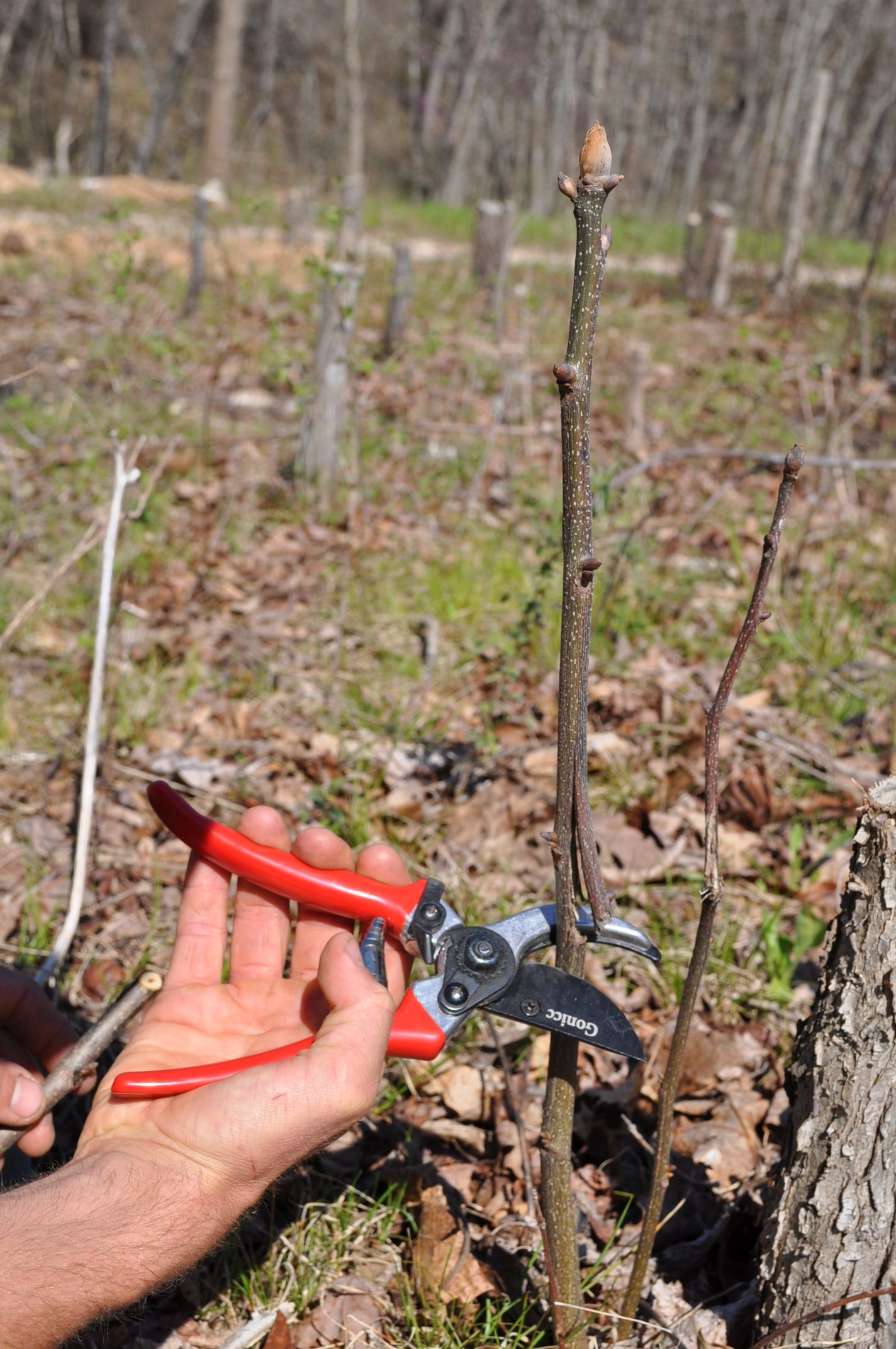
Begin by cutting the rootstock where it is the same diameter as the scion. Cut rootstock at 45 degree angle or steeper.

Make an identical cut in the scion, ensuring the cuts are close to the buds.
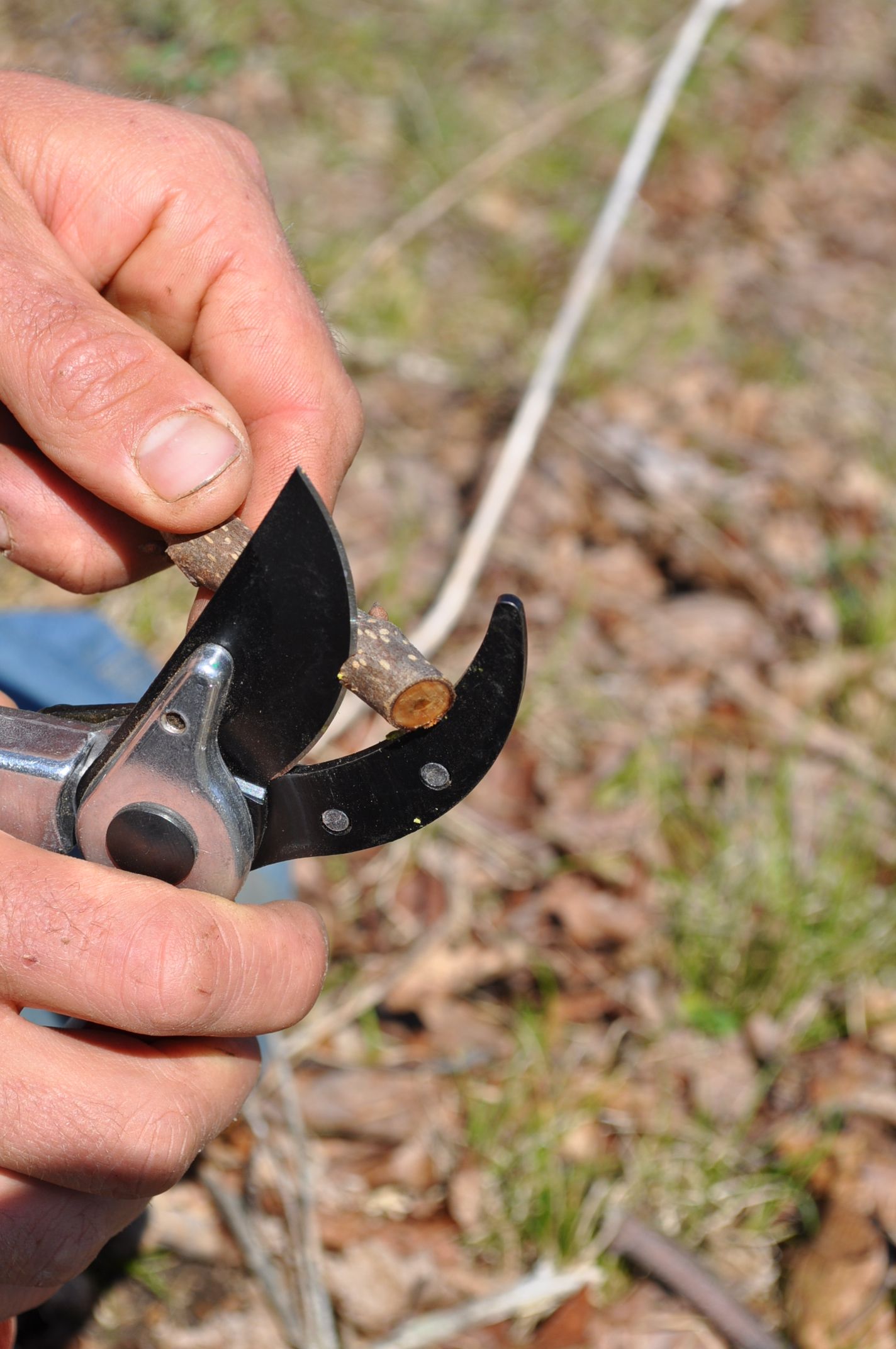
Match the two pieces up and wrap with grafting tape.

This will keep the two pieces tightly bound and retain moisture.
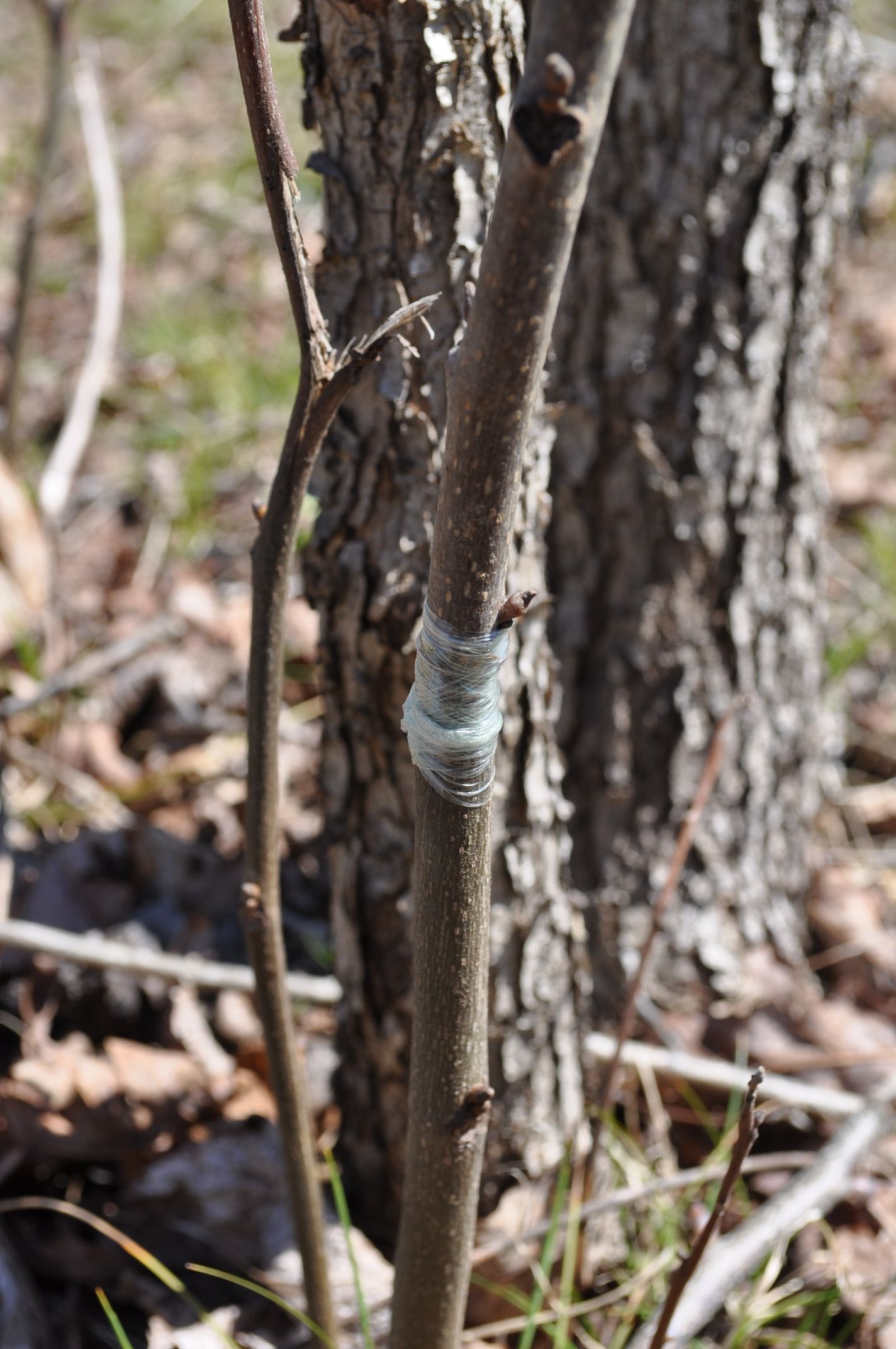
Label with flagging tape, this way if it fails, you are not wasting a metal tag. Check on it periodically and see if the scion leafs out. If so you most likely made a successful graft, Congratulations!

Rosa Whip Graft
Bark Inlay
This type of graft is best used on large rootstocks. It is helpful if the species coppices readily (grows back vigorously when cut) so that if the graft doesn't take, the tree will send up shoots which can be whip grafted next year. For us this method is used on some of the hundreds of American persimmon trees growing wildly on our land.
Start by cutting the rootstock at the base of the tree.
The exact location isn't that important but remember everything above the cut with take of the characteristics of the scion, so you maybe consider cutting low to allow for various pruning options. A sharp pruning saw is a delight to work with and ensures a sharp cut which heals better than a rough one (to keep it sharp store it clean and oiled).
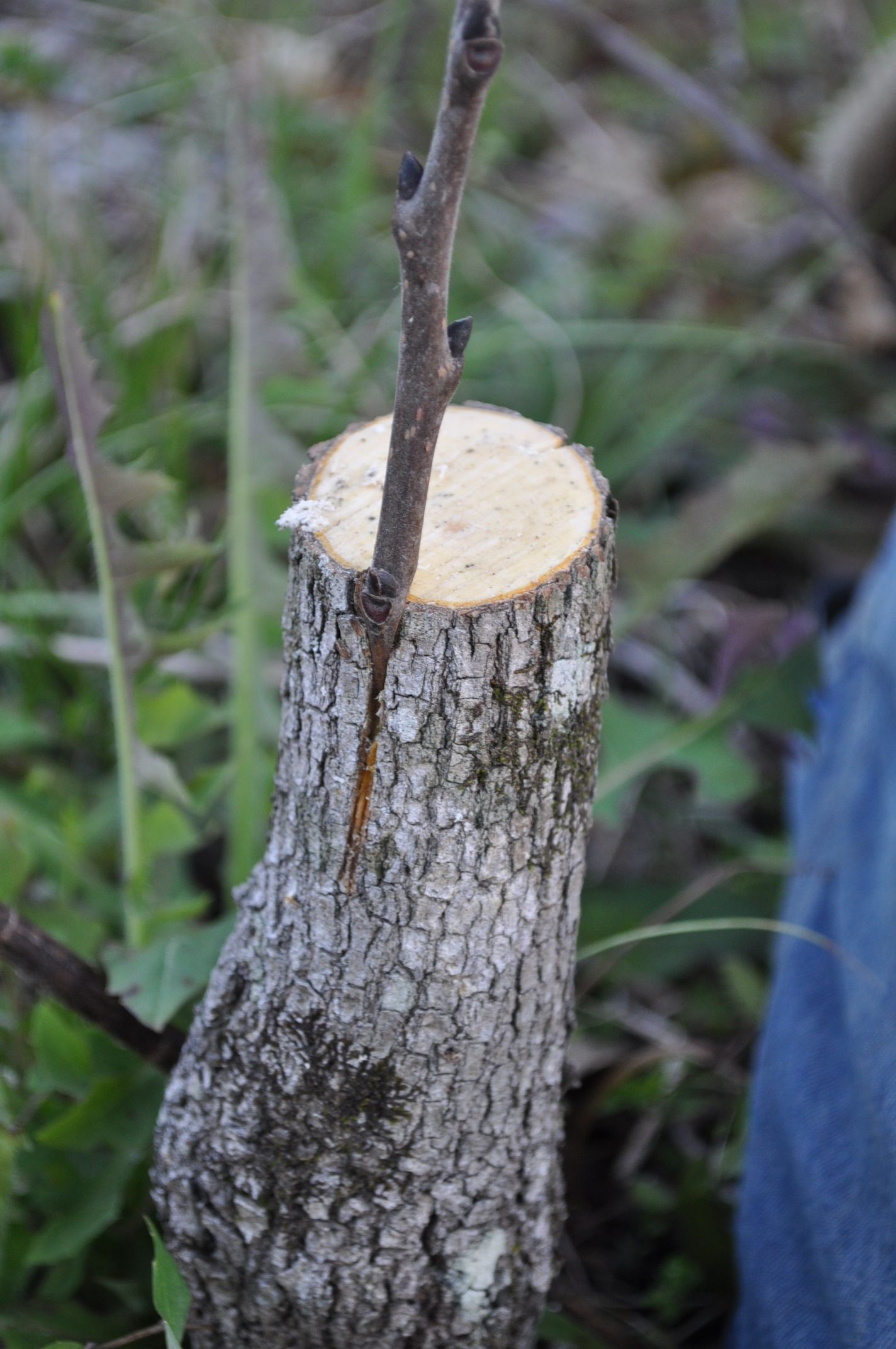
Next is making 2-3 vertical cuts (depending on diameter) with the saw equally spaced around the rootstock.
They should be about as deep as the scion is thick (for us it was 1/4") and 1-4 inches long (the length depends on how long your scion wood is). With a sharp knife (again I use a utility razor blade) make 2 angled cuts tapering towards your saw cut. This will create a triangular relief in the rootstock. Mirror this cut on the scion. This may take practice but be patient, you'll get the hang of it. If done correctly the scion should fit snugly and stay on its own. The important thing to remember is the cambium of both rootstock and scion should align and make solid contact

Once you've completed you 2 or 3 cuts on both rootstock and scion, place all scions in their new home.
Then make several passes around the base of the scions with grafting tape. This will help stabilize the scions and retain moisture. As the sun is intense here, I chose to seal the rootstock as well laying grafting tap over my cut. I do a few more passes horizontally to seal the deal. Again labeling with flagging to keep varieties straight.
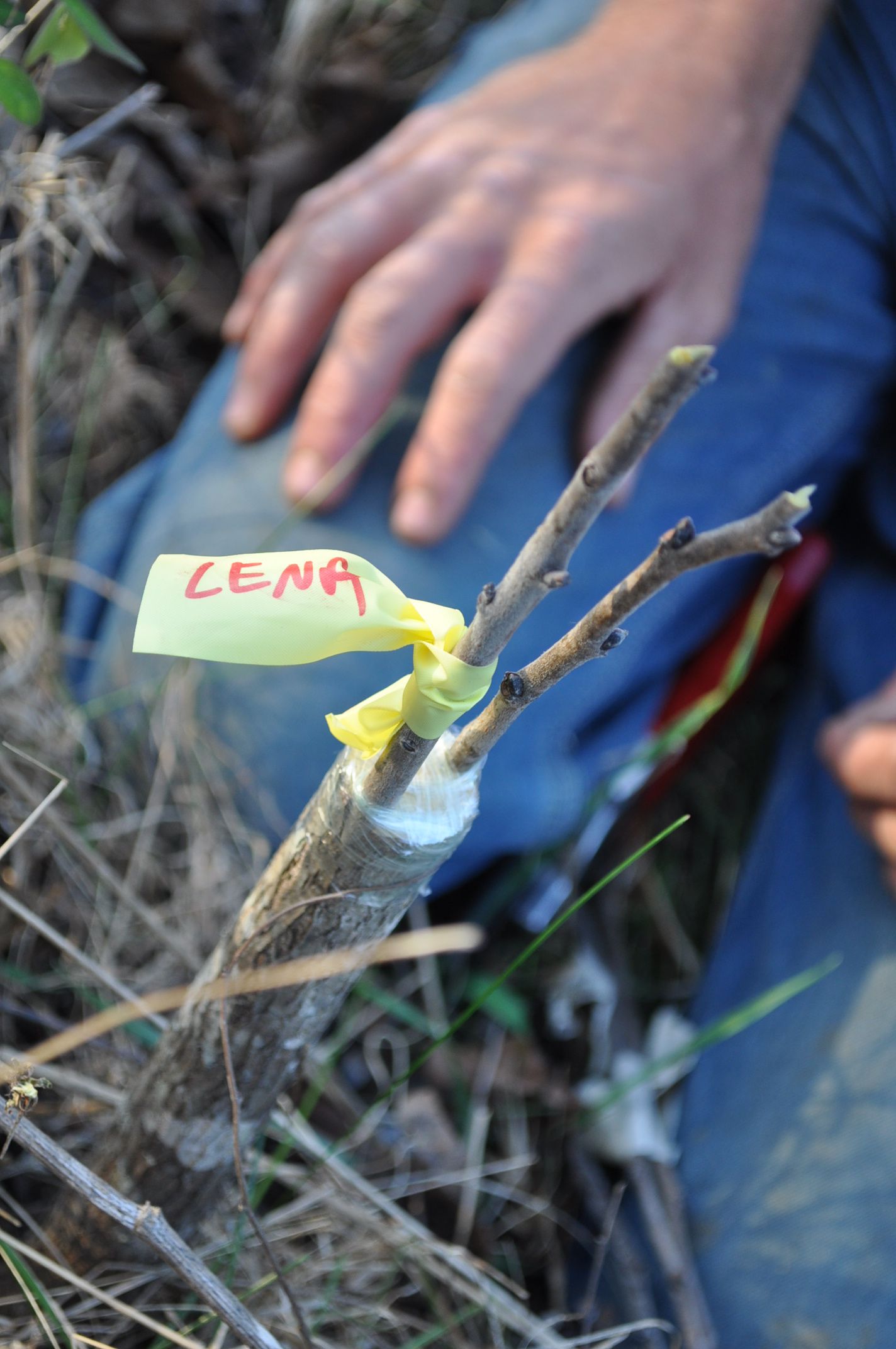
Kerf Graft
This last graft is quite similar to the bark inlay. The main difference is that the kerf (what the saw cuts out) is the only incision on the rootstock and the scions are cut accordingly to pit.
All the same principles apply. After cutting rootstock horizontally, the vertical kerfs are made (2-3 depending on rootstock diameter). Make much steeper cuts that make the scion come to a sharp points. Pry the kerf open (I like using a sturdy flathead screwdriver) before testing the scion for a tight fit. The kerf should close back up and pinch the scion tip. One more time on this one the cambium of both rootstock and scion should align and make solid contact.
Be patient. If at first you don't succeed, keep trying!
Check on your grafts to see how the bud and leaf development is going. If the scion continues to grow leaves you've most likely succeeded. YAY! Don't fret if not though, as nothing is lost if a graft doesn't take, it just gives another opportunity for growth and learning.
We hope to share enthusiastically the joys of working with Earth based cycles and rhythms to ensure a more resilient planet and brighter future and hope this overview of grafting is helpful. Thanks for tuning in! <3
This post was written by a passenger of the #ecotrain; check the tag often for more inspiring material!

Once again, you have written another GREAT post sharing your knowledge and making the instructions so simply even I could do it. Of course, I have added it to Sotall Directory and your post will be highlighted in this weeks update issue! Some day, I am going to make it up ya'lls way and give both of you a BIG HUG!
Awww big hug accepted @fernowl13! Thank you for the appreciation! We live to share this connectedness & skills 😘
Perfect timing. This is the exact info I am looking for. Great instructions with all the photos showing details. Your photos really help someone like me who have not had success with grafting.
yay! glad to hear it comes in such good timing. let us know if you have any ?s :)
Great how to! Very detailed and easy to follow! Well done, perfect timing too as its SPRINGTIME! Love it! You have the perfect tools too! :)
we love those tools you!!! omg makes the job so slick ;) xoxo it's a beautiful spring day here !
Whip grafting seems to be the easiest and fastest. Are there some kinds that should not be paired together?
yes, at the beginning of the post, we talked about it:
Does that help?
Yes, I read that. My question wasn't specific, I'm sorry about that.
So basically it has to be stones or stars for them to work, so then my question would be that it doesn't matter if - for example as I don't know which one has which - I take a lemon and apple tree, as long as it has the same thing? If they don't then they wont work.
Was wondering if there were any exceptions to that or not.
Good line of questioning, and yes there are of course exceptions. There are different botanical families that determine whether grafts will takes. The stones and stars are a very BASIC framework. Apples (an other stars) are in the rosacea family, which is quite distant from say lemons (not sure what family citrus fall into). The stones all fall into the prunus genus.
I would look up compatibility for any specific species you may be interested in. Hope this helps.
Ok, I am new to grafting, so learning from the very beginnings right. I will look that up for sure. Thank you. Where I live we have very few fruit trees, so I have become curious of grafting to see what I can do to actually have one that turns out. Our summers are short and not as hot as where most fruit trees are. We do not have an abundance of apple trees here. I read up on avocado trees, which I have started, but I found that even though I can grow the tree, it will not be fruitful in my area. So what can I do to make that happen? Grafting seems like something to try :)
Where do u live? Curious to see your climatic zone to look up possibilities :)
Northern Ontario (Canada). Zone 2a. 4 months of summer.
whew that's quite cold! you can also look at russian varieties of things as they have a similar climate. you can google zone 2 a cold hardy fruits and nuts and find things around the world that you can grow too! you may be surprised at the wealth of plants that fruit in your area! you probably haven't heard of most of them yet hahah but with an open mind and a little research, you can find them. with a little research this morning i found the following website which you could peruse http://www.sustainablehomesteading.com/edible-and-medicinal-plants/growing-cold-hardy-food-forest-berries-vines-fruit-trees/ ... saw some familiar faces there that we grow!
as far as grafting i'm not specifically sure, but you could try the following fruits and nuts (which would also give you some families of species to try): sea buckthorn, Silverberry Elaeagnus commutata, Buffalo Berry Shepherdia canadensis, look into lowbush blueberries, aronia, cherries, possibly elderberries, maybe mulberry, black walnut (which you can def graft), pine nut... just to start. hope this helps ! :) you could also check out this canadian tree/fruit website for crossovers for your zone :) http://treetime.ca/
Amazing stuff way beyond my capabilities at the moment but I have stored it in the memory for when I have the capacity. Great work ! 💯🐒
:) thanks! so glad to hear of your interest.. it's amazing stuff this grafting :)
Yer seems it! Just need some space to do it haha ! 💯🐒
Congratulations! This post has been upvoted from the communal account, @minnowsupport, by mountainjewel from the Minnow Support Project. It's a witness project run by aggroed, ausbitbank, teamsteem, theprophet0, someguy123, neoxian, followbtcnews, and netuoso. The goal is to help Steemit grow by supporting Minnows. Please find us at the Peace, Abundance, and Liberty Network (PALnet) Discord Channel. It's a completely public and open space to all members of the Steemit community who voluntarily choose to be there.
If you would like to delegate to the Minnow Support Project you can do so by clicking on the following links: 50SP, 100SP, 250SP, 500SP, 1000SP, 5000SP.
Be sure to leave at least 50SP undelegated on your account.
What an excellent post on this! Clear photos, easy to understand text, simple procedures! Thanks for posting this! Resteeming so I can find it.
thanks! glad you find it useful :) thanks for the resteem!
This is awesome, i never thought anything like this existed, cool, agriculture shows it all
:) yes! glad to hear your amazement of the power of agriculture... amazing things are possible :)
Great stuff! I love grafting! Still learning and practicing, but it is going well!
Happy to hear it! Congrats on the success. I too am learning all the time and many years of practice ahead. What species have you focused on? Any luck with Asian persimmons?